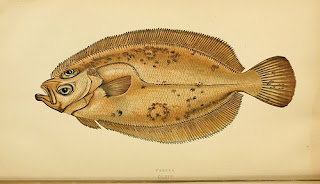Behind the French Menu
by
Bryan G. Newman
behindthefrenchmenu@gmail.com
Megrim
www.flickr.com/photos/biodivlibrary/10574403693/
Cardine, Cardine Franche – Megrim in
the UK and the Limande – the Dab or Common Dab.
Both of these are flat fish with close family members in the turbot
family and flounder families. Their exact names are often confused in the
markets and restaurants, but no one will suffer. These are firm white-fleshed fish that will
be prepared with a sauce and they are the equal of many of their larger and
more expensive cousins. These are the smaller members of their
families and most of those that I have seen were no longer than 25cm
(12”).
In the UK these fish are part of the 40% bi-catch that UK fishermen
and women return to the Atlantic as they would be taking up room reserved for
the money spinners. The most popular
fish in the UK with 50% of the market, salmon,
tuna,
and cod
are mostly imports with all the salmon farmed. (BTW it takes three kilos of wild
fish to feed and produce one kilo of farmed salmon).
Where they can the UK crews
sell the Megrims and Dabs to the French and the Spanish where these fish are
genuinely appreciated; if they don’t manage to sell them, most will be thrown back
into the sea already dead, so they can claim they did not exceed their fishing limits. The
French public is much more adventurous and happy to see these fish on the menu
or in the market at a lower price than brill,
plaice or sole. Both these fish are easily
deboned and served as filets with smaller fish served for one. (Confusion can
arrive when Sole
Limande, Lemon Sole, is on the menu, this is Lemon Sole and another, larger member of the flounder family.
Megrim on French menus:
Filet de Cardine En Croute de Noisette et Café, Poêlée de Salicorne au Beurre Salé et Echalote – A filet of Megrim prepared in a covering of hazelnuts and coffee accompanied by Salicornia (Samphire) pan-fried in salted butter with shallots. (Salted Butter - Beurre Salé, has between 3%- 5% salt and is popular with the morning tartine beurrée. Salicornia or samphire is often called an edible seaweed; it is not. Salicornia, of which there are many family members, grows in salt marshes and along the coast but not in the sea.
Megrim Meunière
www.flickr.com/photos/herry/6661370951/
Limande Meunière Pommes
Vapeur – Megrim prepared in a Sauce Meunier and
accompanied by steamed potatoes. Sauce Meunière is a classic butter sauce made
with lemon juice and parsley added to melted clarified
butter.
Limande Poêlée Entière,
Sauce Vierge - A
whole pan-fried Dab served with a Sauce Vierge. As its name suggests, Sauce Vierge, virgin sauce, includes virgin
olive oil and fresh tomatoes, garlic,
lemon
juice, basil,
red wine vinegar,
salt, and black
pepper. The sauce will be served slightly warm, but not cooked as virgin olive
oil loses its flavor when cooked. The sauce will be poured on the fish just
before it is served.
Megrim with Caper
Butter
www.flickr.com/photos/beckayork/5083548184/
Cardine Farcie aux Huîtres
Gillardeau, Oseille, Beurre
Blanc au Champagne –
Megrim stuffed with Gillardeau
oysters flavored with sorrel and served with Champagne
and white
butter sauce. Gillardeau oysters
come from the family-owned Gillardeau oyster farm that has been farming oysters
in the famous oyster fattening grounds of Marennes-Oléron for over 100
years; Marennes-Oléron is on the Atlantic coast
of the department of Charente
Maritime now part of the new super-region
of Nouvelle Aquitaine. These Label Rouge, Red Label, oysters are
raised on the island of Oleron, opposite to where the town of
Marennes on the mainland leads to the bridge that connects them.
Gillardeau oysters
No 3.
www.flickr.com/photos/claveirole/30295929204/
Suprême de Cardine aux Coques
et Crémeux Passion - A
filet of Megrim prepared with cockles
and a creamy passion fruit sauce.
Coques - Cockles
Dab on French menus:
Tronçons de Limande, Asperge
Blanche et Carottes Nouvelles, Béarnaise
à la Framboise – A filet of Dab accompanied by white asparagus,
young carrots, and Sauce
Bearnaise flavored with raspberries. (Tronçon is the original name used for
filets from flatfish, though, despite its origins tronçon is now used for a cut
of meat also).
White asparagus
www.flickr.com/photos/sunfox/3594612291/
Megrim
and Dab are rarely seen in UK fish counters and their cousins caught close to
North America are equally sparse though those who live close to the coast and
know where the fresh fish markets are will see them fairly often.
Cardin - Megrim in the Languages of France’s neighbors:Catalan - bruixa), (Dutch - scharretong), (German - scheefschnut), (Italian -rombo giallo), (Spanish - ojito ), (Latin - lepidorhombus whiffiagonis).Limande – Dab in the languages of France’s neighbors:(Catalan - limanada), (Dutch - schar), (German - kliesche), (Italian - limanda), (Spanish - limanda), (Latin – limanda limanda).
-----------------------
Behind the French Menu
by
Bryan G. Newman
Copyright 2010, 2019, 2023.
behindthefrenchmenu@gmail.com
---------------------------
Searching for the meaning of words, names or phrases
on
French menus?
Just
add the word, words, or phrase that you are searching for to the words
"Behind the French Menu" (best when including the inverted commas), and
search with Google or Bing, Behind the
French Menu’s links, include hundreds of words, names, and phrases that are
seen on French menus. There are over 470 posts that include over 4,000
French dishes with English translations and explanations.
----------------------------
Connected
Posts:










